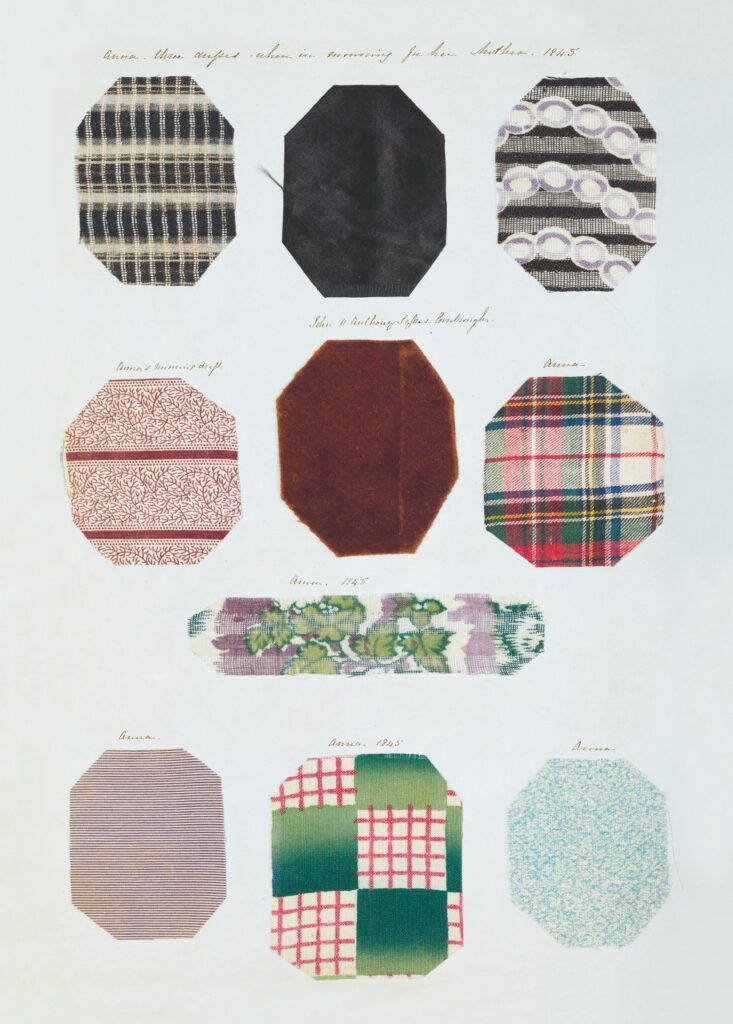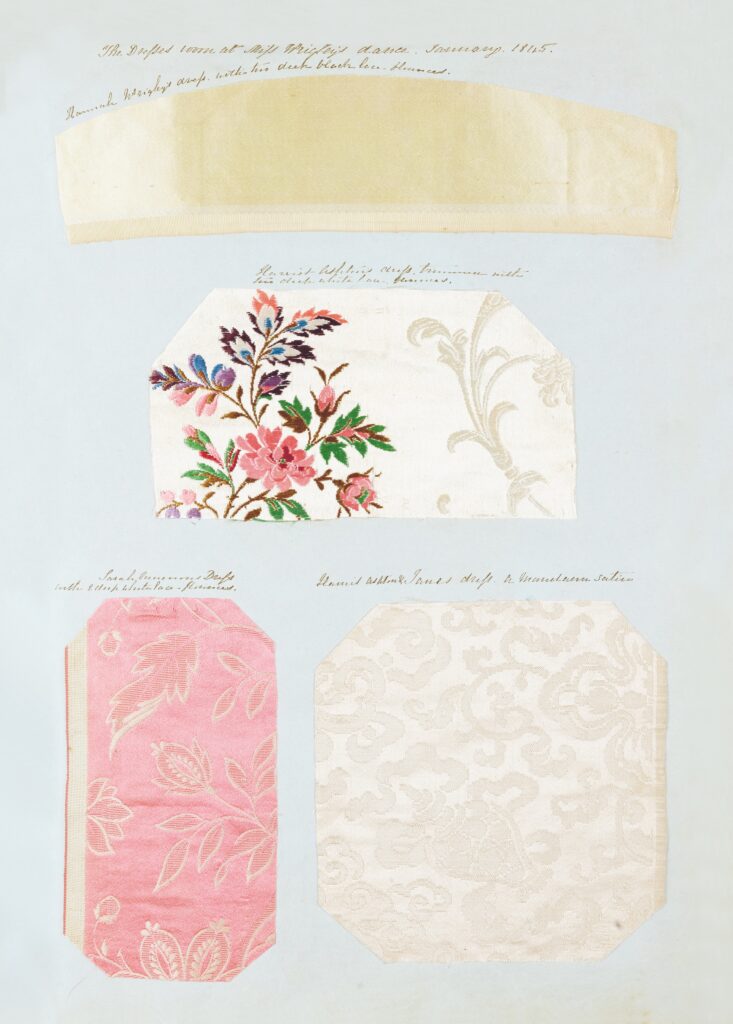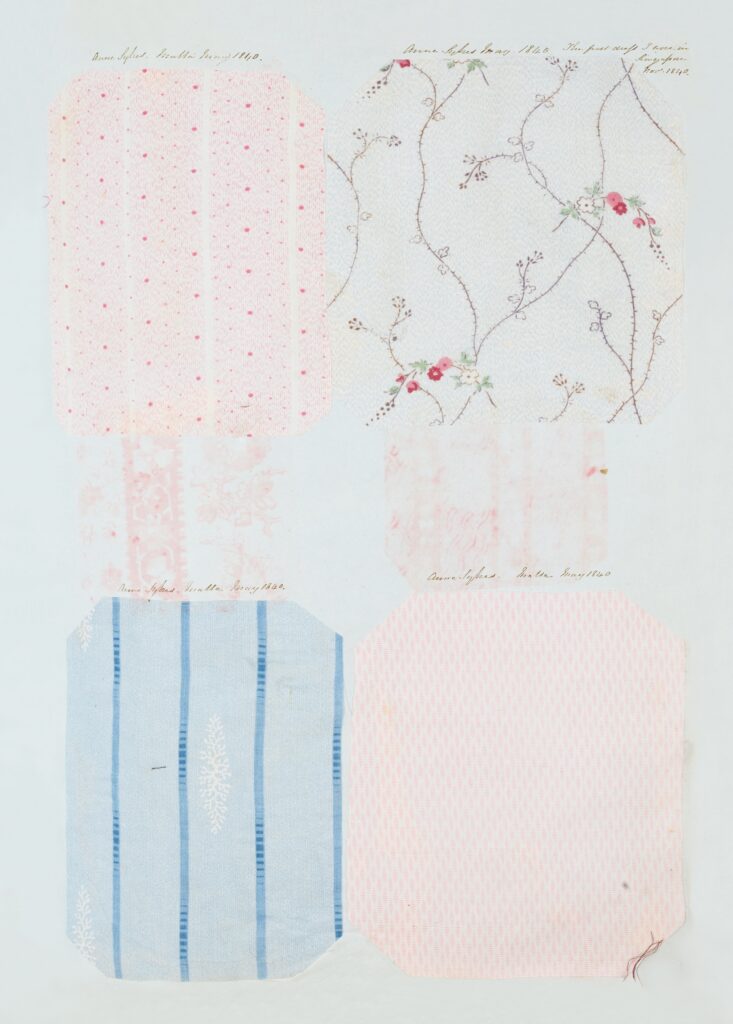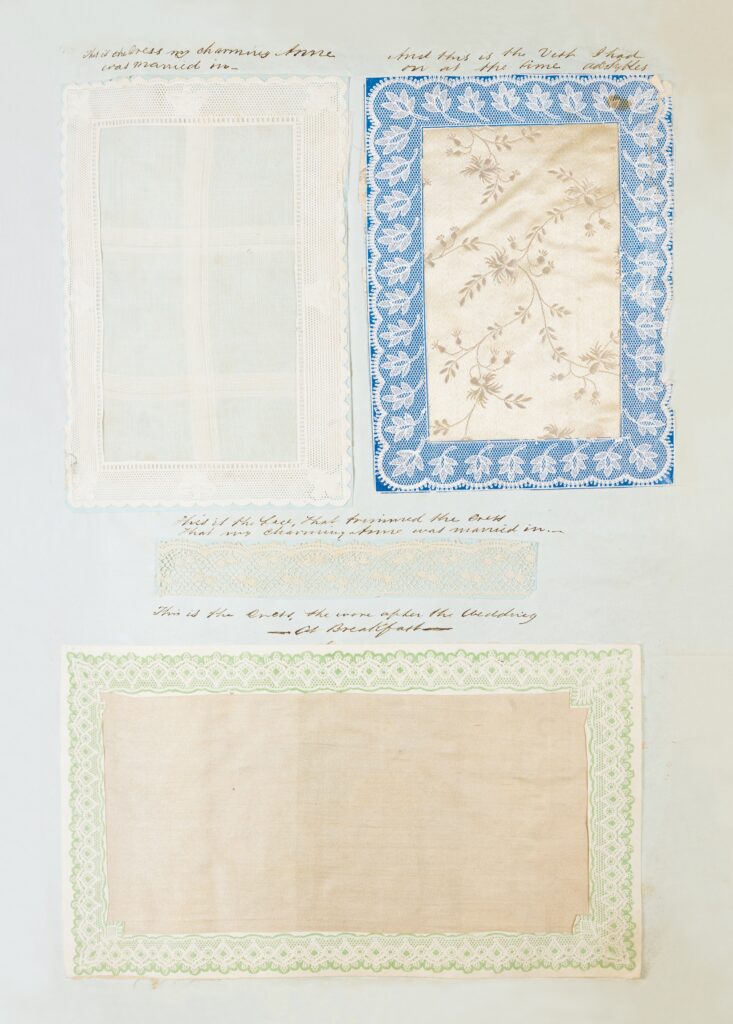The Dress Diary of Mrs. Anne Sykes

“Anna. Three dresses when in mourning for her mother. 1845.” Photograph by Kate Strasdin.
In January 2016 I was given an extraordinary gift. Underneath brown paper that had softened with age and molded to the shape of the object within, I discovered a treasure almost two centuries old that revealed the life of one woman and her broader network of family and friends. It was a book, a ledger of sorts, covered in a bright magenta silk that was frayed along the edge so that a glimpse of its marbled cover was just visible. The shape of the book had distorted—it was narrow at the spine but expanded at the right edge to accommodate the contents, reminding me of my mum’s old recipe book, which had swelled over the years as newspaper cuttings and handwritten notes were added.
This book, measuring some twelve and a half inches long by eight and a half inches across, contained pale blue pages, which were unlined and unmarked. As I carefully opened the front cover and looked at the first page, my breath caught: this was indeed a marvel. Carefully pasted in place were four pieces of fabric, three of them framed in decorative waxed borders—these were scraps of silk important enough to have been memorialized. Accompanying each piece of cloth was a small handwritten note inked in neat copperplate, including a name and a date: 1838.
As I turned more leaves, a kaleidoscope of color and variety unfolded. There were small textile swatches—sometimes only two pieces at a time, and sometimes up to twelve—cut into neat rectangles or octagons and pasted in rows that blossomed across each page. The notes were written above each snippet of fabric, sometimes curving around the shape of it. I knew from the outset that this was something precious, an ephemeral piece of a life lived long ago. It was a beautiful mystery.
The elderly lady who gave me the book explained to me what she knew of its provenance, which was very little. While she was working in the London theater world in the sixties, a young man assisting her in the wardrobe department found this unusual curiosity on a market stall in Camden. He thought that the pages of the scrapbook, filled as they were with colorful textiles, might be of interest to the wardrobes of the theaters where she worked. The book remained in this lady’s possession for fifty years until she passed it on to me.
There was no immediate indication of who might have created this amazing dress diary, as I called it—of who had spent so much time carefully arranging the pieces of wool, silk, cotton, and lace into a document of lives in cloth. While there was much I was uncertain of, however, one thing I knew for sure from the careful handwriting that arched over each piece of cloth: this was the work of one woman. I just didn’t know who she was.
In the months that followed, I began to try and unravel some of the stories that might be contained in the album’s pages. Rather than detail its contents digitally, I had a sense that, to be authentic, I needed to write everything down in longhand. I bought a leather-bound book of handmade paper and a black ink pen and started at the beginning, transcribing each tiny caption. I wrote down names, dates, fabrics, colors, and patterns, trying to see who might emerge, looking out for clues about who the author could have been. I counted more than two thousand pieces of fabric: some patterned, others plain; some large and others much smaller. There were pieces paired with longer captions, and others that bore simply a year or nothing at all.
The book was full of names: Fanny Taylor, Hannah Wrigley, Mary Fletcher, Charlotte Dugdale, Bridgetanne Peacock, Maria Balestier. I recorded more than a hundred different names in the book, binding them to clothes worn long ago. Some appeared with great frequency across its pages and others only fleetingly, acquaintances made and lost among friendships of longer standing.

“The dresses worn at Miss Wrigley’s dance. January 1845.” Photograph by Kate Strasdin.
Only seventy fragments were associated with male garments, and only seventeen of the names recorded were those of men. It seemed that at a time when so much of literature and the arts was focused on the endeavors of men, this was a book dedicated to the world of women. I decided to try to piece together the lives of some of these women through the clues that were left behind, scant though they often were. Using what felt like a forensic approach in its detail, I focused on fragments of cloth to illuminate the world these women inhabited, enabling a wider context to emerge. What began to appear were the tales of an era, placing these lives into the industrial maelstrom of the nineteenth century, with all its noise, color, and innovation.
The structure of the album, the names, and the cloths themselves all suggested that this was not a volume compiled in the rarefied spaces of the aristocracy but something more quotidian: the creator being a woman of some means, but inhabiting the world of the well-to-do middle classes. This woman and others—women whose lives would otherwise go unrecorded, hidden in the shadows of history—found themselves unwittingly front and center in this story.
The practice of making collections of one kind or another was a common activity in the nineteenth century. Taxonomies of the natural world, like cataloguing flora and fauna, abounded. Plant hunters were collecting seeds, entomologists were charting insect life, and in the 1830s—the decade in which this diary commenced—Charles Darwin was beginning to pose his theories outlining evolutionary changes that were to shake the very foundations of scientific understanding. The determination to bring order in a shifting world reached into domestic spaces too, and households around the UK began to create albums of ephemera. Early photographers produced fantastical albums with prints and watercolors, and scrapbooks were filled with keepsakes, autographs, poems, and drawings.
Women’s creative pursuits were many and varied, but rarely were their efforts recognized as anything more than diversions. The decorative handicrafts of women have traditionally been read as acts of leisure: idling away the hours in the domestic spaces afforded to the middle and upper classes, and wasting time on inconsequential endeavors. More recent revisionist histories have begun to challenge these perceptions and to take more seriously the objects made by women—to view them as artistic practices rather than foolish accomplishments. Take Mary Delaney’s botanical collages. At the age of seventy-two, Delaney, whose colorful life up to that point had included friendships with Jonathan Swift, George Frideric Handel, and the great social commentator of the day, William Hogarth, embarked on a project that would become her legacy. She watched one day as a geranium petal fell to the floor and felt compelled to replicate the fragile petal in paper, carefully cutting out its replica. She repeated the process until she had created a life-size collage of the plant, which she called a “flower mosaick.” She then arranged the cutouts onto a piece of black paper and pasted them on. So lifelike was the result that her friend the Duchess of Portland proclaimed that she could not tell the real flower from the paper one.
While the creator of the book I was examining used a pale blue background for her own form of mosaic, Mary Delaney created the inkiest of black backdrops by painting white paper with black watercolor until it was as dark as it could be. She practiced her art form over the next decade, cutting thousands upon thousands of tiny slivers of paper in all the colors of the botanical rainbow to create hundreds of her now-famous collages. “I have invented a new way of imitating flowers,” she wrote in a letter in 1772. So detailed were her creations that botanists still refer to their accuracy, and they are studied with awe at their home in the British Museum.

“The first dress I wore in Singapore.” Photograph by Kate Strasdin.
The dress diary in my possession is rare, but it is not the only one of its kind to remain. One famous surviving example was created by Miss Barbara Johnson, starting in the middle of the eighteenth century and continuing into the early nineteenth century. As a single woman whose finances had to be carefully managed, Johnson began to catalogue the textiles that she purchased to make into clothing. She snipped pieces of precious cloth and pinned them into a large accounting ledger, including details of their type, their cost per yard, and the kind of garments that they would become once sent to the dressmaker. She even pasted in small black-and-white engravings from early fashion publications to indicate the ambitions that she had for her new clothes. For more than seventy years she maintained her album, adding 121 samples to its pages. It served a practical purpose, helping her to balance her books and providing financial clarity. More than that, though, it was a colorful record of Johnson’s journey through life and of the central place that dress played in her day-to-day world. The album was saved by her extended family and eventually became part of the collections at the Victoria and Albert Museum in London, one of their rare treasures. It is the only one of its kind in their collection.
In fact, in the whole of the UK, I failed to find another album like either Barbara Johnson’s or the one that had fallen into my own hands. That is not to say they do not exist, or were not created in greater numbers in decades past. My mystery diarist could not have been the only one in the nineteenth century to choose to record an aspect of her life in this way, and the very tactility of cloth lends itself to this form of remembrance. There may well be volumes of fabric scraps languishing in trunks in attics, or wrapped in the bottom drawer of an elderly chest. There may even be examples that were once catalogued and then forgotten in an archive or a museum, their value yet to be identified.
A dress diary suffers from the double ignominy of being about largely female experiences and about dress—concerns that, in the nineteenth century at least, lent them little by way of artistic merit. The field of dress history has been an academic discipline that has had to fight for recognition amongst more traditionally respected scholarship, the study of clothing being perceived as an ephemeral concern. There have been many occasions during my own career when I have been introduced at an academic conference as a historian studying (cue a long pause and a raised eyebrow) fashion. The slight bemusement that has so often accompanied such introductions reveals a deep-seated perception of dress as superficial and inconsequential—that to be interested in clothing is to lack seriousness. Yet here we all are dressed in clothes, making daily decisions about how we will face the world. We might use dress as our armor, a protective carapace to shield us from censure, or we might use it to express our place and space. Even if we have no interest in fashion, we still choose garments that are indicative in some way of the cultural landscape that shapes each one of us. The creator of my album shared these daily decisions, preferring this color or that fabric in her own environs.
In America there are a handful of albums that share similarities with mine, volumes created by women describing, in material form, the decisions they made about the contents of their wardrobes. Where the diary in my keeping seems to differ from the few other surviving dress diaries is that it recorded lives beyond the maker’s own, encompassing those in her orbit. This woman decided at some point to gather the contents not only of her own wardrobe but those of her family and friends, and to memorialize them in her bright pink silk-covered album. The decision to refer to herself always in the third person made the identification of the author all the more challenging, and, unlike in more intimate diaries, the captions establish a curious distance. Perhaps the point was to try to archive the fabrics objectively rather than making it a personalized object. It is difficult to establish what her motives were. One caption, inked above a woven silk picture of Queen Victoria and Prince Albert, hints at a strategy of collecting. The note reads: “Mr McMicking’s contribution to this book given to him by one of the Gentlemen of the French Embassy to China.” Her note suggests that she was actively sourcing textiles for her book, casting her net far and wide to find interesting additions to its pages. Over tea perhaps, making polite conversation, she may have shown Mr McMicking the book she was compiling and requested that he might add to its pages with a contribution of his choosing.
Finally my careful transcribing of each tiny caption paid off. Across a single square of floral printed cotton, on the top right-hand corner of one of the pages, came the breakthrough I had been hoping for. It was to be the revelation that cracked the code for the entire volume. In the same neat, fine script that populated the whole book were the words “Anne Sykes May 1840. The first dress I wore …” She was revealed. The one and only time that she referred to herself in the first person, Anne Sykes identified herself as the keeper of the book; the creator of its 422 pages; the person who had pasted the 2,134 swatches of fabric into her album and recorded the names of those 104 different people and their clothes. I had found her.
Anne’s identity radiated out in myriad hues and materials, connecting her to her world and allowing us to join her. Discovering that Anne Sykes was the hitherto unknown creator of the book that I had been meticulously transcribing was at once both exciting and perplexing. I felt certain that she had to be a dressmaker, a woman whose role in life was to clothe her clients, taking a keen interest in shape and style, keeping the secrets of bodies. In that moment I could never have anticipated just how much I would be able to uncover.
Swatches in the album revealed that Anne attended parties and fancy balls, her book being full of the formal clothes that both she and her friends wore on these occasions. It was full, too, of the everyday—of cotton and wool, of dressing gowns and slippers, bonnet ribbons, petticoats, and cloaks. Cloth of all types was a valued commodity and its purchase was not undertaken on a whim. She recorded the purchases that she made from Miss Brennand’s smallwares establishment and on shopping trips that her friends made to Liverpool and Manchester. Individually the swatches gave little away, but by piecing together clues, it was possible to weave together the strands of Anne’s life into a colorful patchwork of family and friends.

“This is the dress my charming Anne was married in.” Photograph by Kate Strasdin.
That Anne kept her dress diary more or less chronologically is evident from its structure and the dates recorded. The album starts at the very commencement of Queen Victoria’s reign and maps those momentous decades of everything that came to be Victorian—a parallel life synonymous with industry and empire. Although the notes are brief, the writing changes. As the years pass, the notes become scarcer and the fine copperplate larger and not so neatly formed. All of life is revealed as the pages progress: mourning clothes to mark the loss of loved ones, dresses worn to christenings, gifts for birthdays and Christmases.
In a sense, Anne’s album is a form of life writing—taking in ordinary folk, not the grandees of traditional written histories but the bystanders, the participants in everyday life, their loves and losses, joys and sorrows. It is a fragmentary story of life experienced at home and abroad, in a domestic world and an international one, of courage in unfamiliar lands and of building a community of friends. Through small and seemingly inconsequential wisps of fabric, Anne Sykes’s diary lays bare the whole of human experience in that most intimate of mediums: the clothes that we choose to wear.
Dr. Kate Strasdin is a fashion historian, museum curator and lecturer at Falmouth University, where she teaches the history of fashion design, marketing, and photography.
From The Dress Diary: Secrets from a Victorian Woman’s Wardrobe, out from Pegasus Books this June.
Copyright
© The Paris Review
